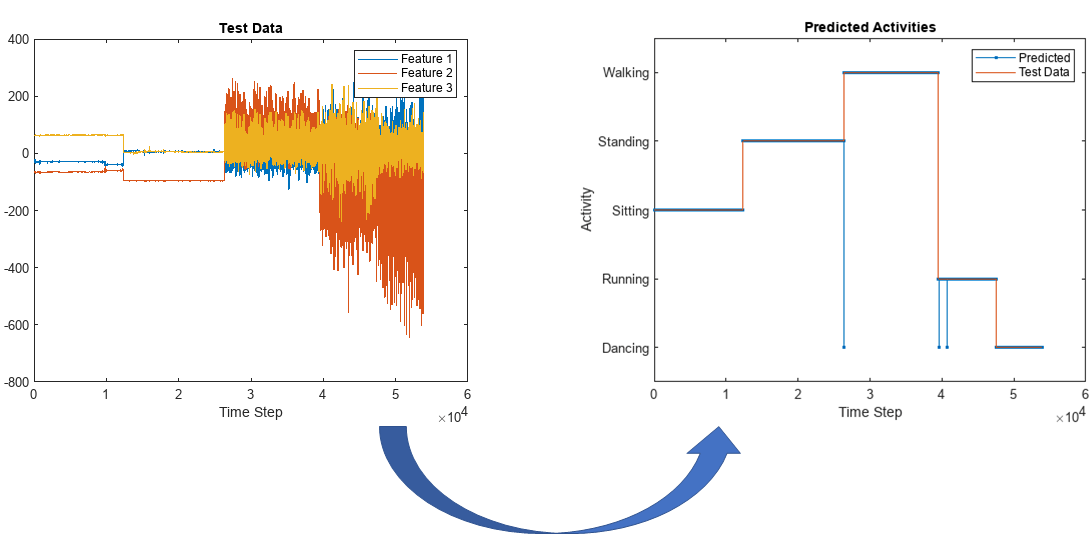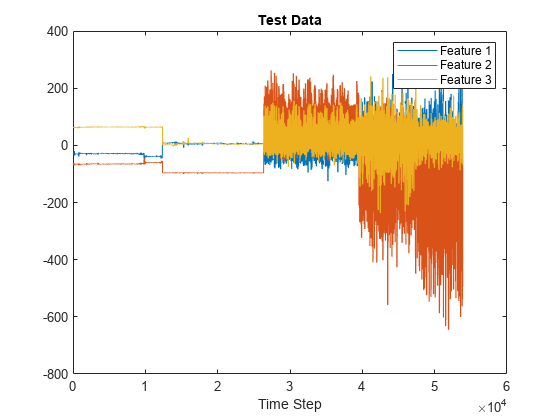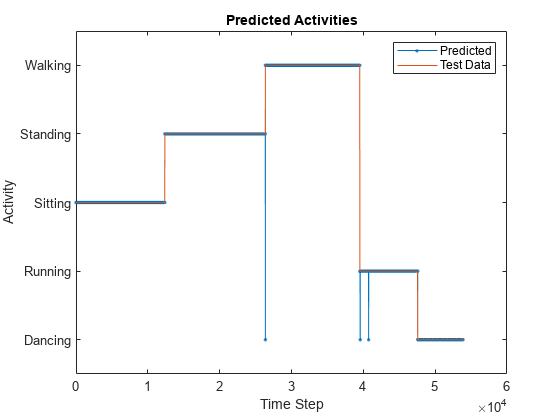Run Sequence-to-Sequence Classification on Intel FPGA
This example shows how to create, compile, and deploy a long short-term memory (LSTM) network trained on accelerometer data from human movement by using the Deep Learning HDL Toolbox™ Support Package for Intel® FPGA and SoC. Use the deployed network to classify human activity based on sequence input data. Use MATLAB® to retrieve the prediction results from the target device.
This example uses the network trained in the Sequence-to-Sequence Classification Using Deep Learning. This example uses sensor data obtained from a smartphone worn on the body and deploys an LSTM network trained to recognize the activity of the wearer based on time series data that represents accelerometer readings in three different directions. The graphs below show the raw data for these accelerometer readings over time and the resulting classifications. The training data contains time series data for seven people. Each sequence has three features and varies in length. The data set contains six training observations and one test observation.

Prerequisites
Intel Arria® 10 SoC development board
Load the Pretrained Network
To load the pretrained human body movement network, enter:
load SequenceToSequenceClassificationView the layers of the network by using the Deep Network Designer app.
deepNetworkDesigner(net)
Define FPGA Board Interface
Define the target FPGA board programming interface by creating a dlhdl.Target object. Specify that the interface is for a Intel board with an Ethernet interface. A JTAG interface can also be used.
To create the target object, enter:
hTarget = dlhdl.Target("Intel", "Interface", "Ethernet");
To use the JTAG interface, install Intel Quartus® Prime Standard Edition 22.1. To set the Intel Quartus Prime Standard Edition tool path, enter:
hdlsetuptoolpath('ToolName', 'Altera Quartus II', 'ToolPath', 'C:\altera\22.1\quartus\bin64');
Prepare Network for Deployment
Prepare the network for deployment by creating a dlhdl.Workflow object. Specify the network and bitstream name. Ensure that the bitstream name matches the data type and FPGA board. In this example, the target FPGA board is the Intel Arria 10 SOC board. The bitstream uses a single data type.
hW = dlhdl.Workflow('network',net,'Bitstream','arria10soc_lstm_single','Target',hTarget);
Compile Network
Run the compile method of the dlhdl.Workflow object to compile the network and generate the instructions, weights, and biases for deployment. Because the total number of frames exceeds the default value, set the InputFrameNumberLimit name-value argument to 55,000.
dn = compile(hW,'InputFrameNumberLimit',55000)### Compiling network for Deep Learning FPGA prototyping ...
### Targeting FPGA bitstream arria10soc_lstm_single.
### An output layer called 'Output1_softmax' of type 'nnet.cnn.layer.RegressionOutputLayer' has been added to the provided network. This layer performs no operation during prediction and thus does not affect the output of the network.
### The network includes the following layers:
1 'sequenceinput' Sequence Input Sequence input with 3 dimensions (SW Layer)
2 'lstm' LSTM LSTM with 200 hidden units (HW Layer)
3 'fc' Fully Connected 5 fully connected layer (HW Layer)
4 'softmax' Softmax softmax (SW Layer)
### Notice: The layer 'softmax' with type 'nnet.cnn.layer.SoftmaxLayer' is implemented in software.
### Notice: The layer 'sequenceinput' with type 'nnet.cnn.layer.ImageInputLayer' is implemented in software.
### Notice: The layer 'Output1_softmax' with type 'nnet.cnn.layer.RegressionOutputLayer' is implemented in software.
### Compiling layer group: lstm.wi ...
### Compiling layer group: lstm.wi ... complete.
### Compiling layer group: lstm.wo ...
### Compiling layer group: lstm.wo ... complete.
### Compiling layer group: lstm.wg ...
### Compiling layer group: lstm.wg ... complete.
### Compiling layer group: lstm.wf ...
### Compiling layer group: lstm.wf ... complete.
### Compiling layer group: fc ...
### Compiling layer group: fc ... complete.
### Allocating external memory buffers:
offset_name offset_address allocated_space
_______________________ ______________ _______________
"InputDataOffset" "0x00000000" "3.4 MB"
"OutputResultOffset" "0x0035c000" "3.4 MB"
"SchedulerDataOffset" "0x006b8000" "868.0 kB"
"SystemBufferOffset" "0x00791000" "20.0 kB"
"InstructionDataOffset" "0x00796000" "4.0 kB"
"FCWeightDataOffset" "0x00797000" "680.0 kB"
"EndOffset" "0x00841000" "Total: 8.3 MB"
### Network compilation complete.
dn =
struct with fields:
weights: [1×1 struct]
instructions: [1×1 struct]
registers: [1×1 struct]
syncInstructions: [1×1 struct]
constantData: {}
ddrInfo: [1×1 struct]
resourceTable: [6×2 table]
Program Bitstream on FPGA and Download Network Weights
To deploy the network on the Intel Arria 10 SoC hardware, run the deploy method of the dlhdl.Workflow object. This function uses the output of the compile function to program the FPGA board and download the network weights and biases. The deploy function programs the FPGA device and displays progress messages, and the required time to deploy the network.
deploy(hW)
### Programming FPGA Bitstream using Ethernet... ### Attempting to connect to the hardware board at 172.21.89.235... ### Connection successful ### Programming FPGA device on Intel SoC hardware board at 172.21.89.235... ### Attempting to connect to the hardware board at 172.21.89.235... ### Connection successful ### Copying FPGA programming files to SD card... ### Setting FPGA bitstream and devicetree for boot... WARNING: Uboot script u-boot.scr detected, this may override boot settings # Copying Bitstream arria10soc_lstm_single.core.rbf to /mnt/hdlcoder_rd # Set Bitstream to hdlcoder_rd/arria10soc_lstm_single.core.rbf # Copying Devicetree devicetree_dlhdl.dtb to /mnt/hdlcoder_rd # Set Devicetree to hdlcoder_rd/devicetree_dlhdl.dtb # Set up boot for Reference Design: 'LIBIIO CNN system with 3 AXI4 Master' ### Rebooting Intel SoC at 172.21.89.235... ### Reboot may take several seconds... ### Attempting to connect to the hardware board at 172.21.89.235... ### Connection successful ### Programming the FPGA bitstream has been completed successfully. ### Resetting network state. ### Loading weights to FC Processor. ### FC Weights loaded. Current time is 29-Aug-2024 11:33:21
Load Human Activity Test Data
Load the test data and classify the activity at each time step. Each sequence has three features and varies in length. The three features correspond to the accelerometer readings in three different directions.
Load the human activity test data. XTest contains a single sequence of dimension 3. YTest contains a sequence of categorical labels that correspond to the activity at each time step.
load HumanActivityTest numFeatures = 3; figure plot(XTest{1}') xlabel("Time Step") legend("Feature " + (1:numFeatures)) title("Test Data")

Run the Prediction
Classify the test data.
XTest{1} = dlarray(XTest{1}, 'CT');
YPred = predict(hW.Network, XTest{1});
YPred = scores2label(YPred, categories(YTest{1}));Calculate the accuracy of the prediction.
acc = sum(YPred == YTest{1})./numel(YTest{1})acc = 0.9995
Compare the predictions with the test data by using a plot.
figure plot(YPred,'.-') hold on plot(YTest{1}) hold off xlabel("Time Step") ylabel("Activity") title("Predicted Activities") legend(["Predicted" "Test Data"])

Compare this graph to the output of the predict method.
Run the predict method of the dlhdl.Workflow object, to retrieve the hardware prediction results.
predictions = hW.predict(XTest{1}, Profile='on');### Resetting network state.
### Finished writing input activations.
### Running a sequence of length 53888.
Deep Learning Processor Profiler Performance Results
LastFrameLatency(cycles) LastFrameLatency(seconds) FramesNum Total Latency Frames/s
------------- ------------- --------- --------- ---------
Network 18628 0.00012 53888 1029435175 7852.1
memSeparator_2 78 0.00000
memSeparator_0 245 0.00000
lstm.wi 3820 0.00003
lstm.wo 3841 0.00003
lstm.wg 3856 0.00003
lstm.wf 3938 0.00003
lstm.sigmoid_1 267 0.00000
lstm.sigmoid_3 267 0.00000
lstm.tanh_1 247 0.00000
lstm.sigmoid_2 251 0.00000
lstm.multiplication_1 307 0.00000
lstm.multiplication_2 271 0.00000
lstm.c_add 261 0.00000
lstm.tanh_2 281 0.00000
lstm.multiplication_3 211 0.00000
fc 443 0.00000
memSeparator_1 44 0.00000
* The clock frequency of the DL processor is: 150MHz
save("hardwarepredictions.mat","predictions") actions = scores2label(predictions, categories(YTest{1}));
Calculate the accuracy of the FPGA board prediction.
accFPGA = sum(actions == YTest{1})./numel(YTest{1})accFPGA = 0.9995
Plot the comparison between the FPGA board predictions and test data.
figure plot(actions,'.-') hold on plot(YTest{1}) hold off xlabel("Time Step") ylabel("Activity") title("Predicted Activities") legend(["Predicted" "Test Data"])

The hardware-predicted activities are similar to the simulation results.
See Also
dlhdl.Workflow | dlhdl.Target | compile | deploy | predict | predictAndUpdateState | resetState